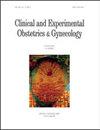The Value of TruScreen (An Artificial Intelligence Cervical Cancer Screening System) in High-Risk HPV Positive Patients
IF 0.6
4区 医学
Q4 OBSTETRICS & GYNECOLOGY
引用次数: 0
Abstract
Background: To investigate the value of the artificial intelligence cervical cancer screening system TruScreen (TS) in high-risk human papillomavirus (HPV)-positive patients in a clinical setting. Methods: Three hundred and eighteen patients positive for high-risk HPV in the gynecological clinic of our hospital from May 2020 to June 2021 were analyzed retrospectively. Colposcopy was performed when it was clinically indicated. Results: Among the 318 patients, 203 were TS negative and 115 were TS positive, of whom 84 were referred for colposcopy and possible biopsy. Among the 318 patents, 74.53% (237/318) had a single type of HPV infection, and 25.47% (81/318) had more than two types of HPV infection. In terms of HPV types, the top 5 types were 52, 58, 51, 56 and 16. HPV52 accounted for 27.4% (87/318), followed by HPV58, accounting for 17.30% (55/318). A total of 84 patients underwent colposcopy. The negative predictive values of TS and thinprep cytology test (TCT) screening for cervical cancer and precancerous lesions were 33.33% and 16.90%, respectively. The positive predictive values were 88.41% and 92.31%, respectively. The sensitivity was 85.92% and 16.90%, respectively. The specificity was 38.46% and 92.31%, respectively. Among 251 non-16/18 high-risk HPV-positive patients with TCT negative intraepithelial lesion or malignancy (NILM) 49 underwent colposcopy. The positive predictive value of TS for cervical cancer and precancerous lesions was 84.78% and the sensitivity was 92.86%. Conclusions: This study demonstrated that in a clinical setting, TS had a better sensitivity than TCT in cervical cancer screening, but less specificity than TCT. In the non-16/18 HPV-positive population with TCT NILM, TS screening can be considered as having potential for clinical management. However, the current research sample size was small, and further research needs to be performed with a larger sample size.人工智能宫颈癌筛查系统TruScreen在高危HPV阳性患者中的应用价值
背景:探讨人工智能宫颈癌筛查系统trusscreen (TS)在高危人乳头瘤病毒(HPV)阳性患者中的临床应用价值。方法:回顾性分析2020年5月至2021年6月我院妇科门诊高危HPV阳性患者318例。临床指征时行阴道镜检查。结果:318例患者中,TS阴性203例,TS阳性115例,其中84例行阴道镜检查和活检。318件专利中,74.53%(237/318)存在单一类型HPV感染,25.47%(81/318)存在两种以上HPV感染。HPV型别前5位分别为52型、58型、51型、56型和16型。HPV52占27.4%(87/318),其次是HPV58,占17.30%(55/318)。共有84例患者接受阴道镜检查。TS和TCT筛查宫颈癌和癌前病变的阴性预测值分别为33.33%和16.90%。阳性预测值分别为88.41%和92.31%。灵敏度分别为85.92%和16.90%。特异性分别为38.46%和92.31%。251例TCT阴性上皮内病变或恶性肿瘤(NILM)的非16/18高危hpv阳性患者中,49例行阴道镜检查。TS对宫颈癌及癌前病变的阳性预测值为84.78%,敏感性为92.86%。结论:本研究表明,在临床环境下,TS在宫颈癌筛查中的敏感性优于TCT,但特异性低于TCT。在非16/18 hpv阳性的TCT NILM人群中,TS筛查可被认为具有临床管理的潜力。但是,目前的研究样本量较少,需要进一步扩大样本量进行研究。
本文章由计算机程序翻译,如有差异,请以英文原文为准。
求助全文
约1分钟内获得全文
求助全文
来源期刊
CiteScore
0.50
自引率
0.00%
发文量
241
审稿时长
1 months
期刊介绍:
CEOG is an international, peer-reviewed, open access journal. CEOG covers all aspects of Obstetrics and Gynecology, including obstetrics, prenatal diagnosis, maternal-fetal medicine, perinatology, general gynecology, gynecologic oncology, uro-gynecology, reproductive medicine, infertility, reproductive endocrinology, sexual medicine. All submissions of cutting-edge advances of medical research in the area of women''s health worldwide are encouraged.

 求助内容:
求助内容: 应助结果提醒方式:
应助结果提醒方式:


